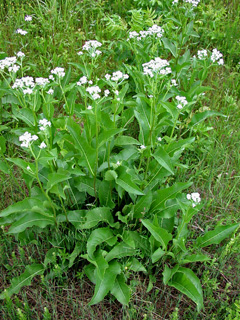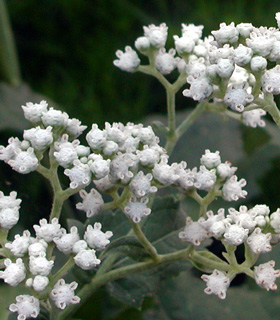Resource Library
Plant of the Week: American Feverfew, Wild Quinine
Plant of the Week

American Feverfew or Wild Quinine is a midsummer blooming native wildflower throughout the eastern states. (Image courtesy Gerald Klingaman)
American Feverfew, Wild Quinine
Latin: Parthenium integrifolium
Over the years I've relied on the botanical group of the plant family to help me understand plants and relate new and unfamiliar species to those I know. For several years I've walked by plantings of Wild Quinine or American Feverfew (Parthenium integrifolium) without really stopping to observe it up close. As I researched the web for this piece, I was surprised to find it belonged to the old, large daisy family.
American feverfew is an herbaceous perennial growing 2 to 4 feet tall when in flower in midsummer. It ranges throughout the eastern states from Texas to New England where it occurs in dry, forest glades or in open, exposed prairie sites. It is one of 16 species found in the New World with three species found in Arkansas. American feverfew is the most widely distributed species and the only one that seems to be grown in gardens.
In a good site wild quinine can be long lived, producing a rosette of large, coarse textured serrate leaves to 6 inches long. In early summer it sends forth an erect growing stem with smaller, alternately arranged leaves. The leaves are aromatic when crushed and sandpapery in texture. Plants produce a deep taproot with the crown spreading horizontally via short rhizomes.
The flower heads are pearly white and about one-third of an inch across and borne in flat- topped clusters. The head is composed of short disk flowers with very few small, ray flowers produced in each head. It looks as if the flower is always on the verge of opening up and showing more but it never does. The inflorescence branches from the base and the plant remains in bloom from mid-June until mid-August. Because the head has all ray flowers, the inflorescence makes a good dried wildflower.
 Wild Quinine doesn't much look like a member of the daisy family but it is. (Image
courtesy Gerald Klingaman)
Wild Quinine doesn't much look like a member of the daisy family but it is. (Image
courtesy Gerald Klingaman)
American feverfew has a long history of use in medicine. The Quapaw Indians used its crushed leaves as a poultice for burns and made a concoction to treat horses. Early European settlers, because of its bitter taste, used it to treat various internal ailments. Supposedly in World War I a shortage of quinine, extracted from the bark of a tropical tree, was feared so leaves of this plant were stockpiled in anticipation of a need that never materialized. The wild quinine name seems to have originated about this time, supplanting the feverfew name.
American feverfew is a good addition to background sites around the garden where a tough survivor is needed. It should have at least six hours of sunlight and a well-drained soil. Wet soils tend to hasten its demise. It is a good addition to a native prairie, a wildflower border or the front of a west facing woodlot. Propagation is primarily by seed, which should be stratified for six to eight weeks before planting.
(468 words )
By: Gerald Klingaman, retired
Retired Extension Horticulturist - Ornamentals
Extension News - July 25, 2014
The University of Arkansas System Division of Agriculture does not maintain lists of retail outlets where these plants can be purchased. Please check your local nursery or other retail outlets to ask about the availability of these plants for your growing area.